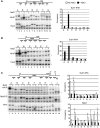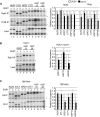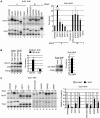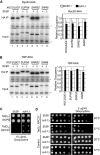Sub1 functions in osmoregulation and in transcription by both RNA polymerases II and III
- PMID: 19204085
- PMCID: PMC2663309
- DOI: 10.1128/MCB.01841-08
Sub1 functions in osmoregulation and in transcription by both RNA polymerases II and III
Abstract
Sub1 is implicated in transcriptional activation, elongation, and mRNA 3'-end formation in budding yeast. To gain more insight into its function, we performed a synthetic genetic array screen with SUB1 that uncovered genetic interactions with genes involved in the high-osmolarity glycerol (HOG) osmoresponse pathway. We find that Sub1 and the HOG pathway are redundant for survival in moderate osmolarity. Chromatin immunoprecipitation analysis shows that Sub1 is recruited to osmoresponse gene promoters during osmotic shock and is required for full recruitment of TBP, TFIIB, and RNA polymerase II (RNAP II) at a subset of these genes. Furthermore, we detect Sub1 at the promoter of every constitutively transcribed RNAP II and, unexpectedly, at every RNAP III gene tested, but not at the RNAP I-transcribed ribosomal DNA promoter. Significantly, deletion of SUB1 reduced levels of promoter-associated RNAP II or III at these genes, but not TBP levels. Together these data suggest that, in addition to a general role in polymerase recruitment at constitutive RNAP II and RNAP III genes, during osmotic shock, Sub1 facilitates osmoresponse gene transcription by enhancing preinitiation complex formation.
Figures








Similar articles
-
The transcriptional coactivator PC4/Sub1 has multiple functions in RNA polymerase II transcription.EMBO J. 2005 Mar 9;24(5):1009-20. doi: 10.1038/sj.emboj.7600575. Epub 2005 Feb 3. EMBO J. 2005. PMID: 15692559 Free PMC article.
-
Sub1 associates with Spt5 and influences RNA polymerase II transcription elongation rate.Mol Biol Cell. 2012 Nov;23(21):4297-312. doi: 10.1091/mbc.E12-04-0331. Epub 2012 Sep 12. Mol Biol Cell. 2012. PMID: 22973055 Free PMC article.
-
High-resolution protein-DNA contacts for the yeast RNA polymerase II general transcription machinery.Biochemistry. 2004 Oct 12;43(40):12741-9. doi: 10.1021/bi048993r. Biochemistry. 2004. PMID: 15461446
-
Specialization of RNA Polymerase I in Comparison to Other Nuclear RNA Polymerases of Saccharomyces cerevisiae.Methods Mol Biol. 2022;2533:63-70. doi: 10.1007/978-1-0716-2501-9_4. Methods Mol Biol. 2022. PMID: 35796982 Free PMC article. Review.
-
Sub1/PC4 a chromatin associated protein with multiple functions in transcription.RNA Biol. 2010 May-Jun;7(3):287-90. doi: 10.4161/rna.7.3.11491. Epub 2010 May 9. RNA Biol. 2010. PMID: 20305379 Review.
Cited by
-
Sub1/PC4, a multifaceted factor: from transcription to genome stability.Curr Genet. 2017 Dec;63(6):1023-1035. doi: 10.1007/s00294-017-0715-6. Epub 2017 May 31. Curr Genet. 2017. PMID: 28567479 Review.
-
Sub1 and Maf1, two effectors of RNA polymerase III, are involved in the yeast quiescence cycle.PLoS One. 2014 Dec 22;9(12):e114587. doi: 10.1371/journal.pone.0114587. eCollection 2014. PLoS One. 2014. PMID: 25531541 Free PMC article.
-
The Role of S. cerevisiae Sub1/PC4 in Transcription Elongation Depends on the C-Terminal Region and Is Independent of the ssDNA Binding Domain.Cells. 2022 Oct 21;11(20):3320. doi: 10.3390/cells11203320. Cells. 2022. PMID: 36291192 Free PMC article.
-
Sub1 and RNAPII, until termination does them part.Transcription. 2018;9(1):52-60. doi: 10.1080/21541264.2017.1333558. Epub 2017 Aug 30. Transcription. 2018. PMID: 28853990 Free PMC article. Review.
-
Barcode Sequencing Screen Identifies SUB1 as a Regulator of Yeast Pheromone Inducible Genes.G3 (Bethesda). 2016 Apr 7;6(4):881-92. doi: 10.1534/g3.115.026757. G3 (Bethesda). 2016. PMID: 26837954 Free PMC article.
References
-
- Albertyn, J., S. Hohmann, J. M. Thevelein, and B. A. Prior. 1994. GPD1, which encodes glycerol-3-phosphate dehydrogenase, is essential for growth under osmotic stress in Saccharomyces cerevisiae, and its expression is regulated by the high-osmolarity glycerol response pathway. Mol. Cell. Biol. 144135-4144. - PMC - PubMed
-
- Alepuz, P. M., A. Jovanovic, V. Reiser, and G. Ammerer. 2001. Stress-induced map kinase Hog1 is part of transcription activation complexes. Mol. Cell 7767-777. - PubMed
-
- Brewster, J. L., T. de Valoir, N. D. Dwyer, E. Winter, and M. C. Gustin. 1993. An osmosensing signal transduction pathway in yeast. Science 2591760-1763. - PubMed
Publication types
MeSH terms
Substances
LinkOut - more resources
Full Text Sources
Other Literature Sources
Medical
Molecular Biology Databases
